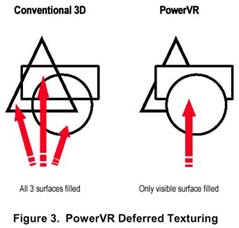3DWorkshop heeft een preview inelkaar gedraait van de een nieuwe videokaart van STMicro, de Kyro. Deze kaart gaat in iedergeval een stuk beter om met fillrate dan de meeste 3D kaarten die je nu op de markt ziet, de Kyro hoeft niet alle textures te renderen die niet zichtbaar zijn. Naast dat krijgt de chip ook nog een ontwerp wat erg goed moet kunnen scalen, het toevoegen van wat extra rendering pipelines of chippies hoeft geen problemen op te leveren ![]() :
:
'Deferred Texturing'. In PowerVR systems (KYRO) the hidden surface removal (read above) is completed in the first phase of the rendering pipeline, i.e before texturing and shading. The result is that only the visible pixels, to be finally drawn in the display memory, are texturing and shaded eliminating the redundant work performed (filling a pixel and then discarding it discussed earlier) and most importantly, the redundant texture fetches from external memory (which has a rather limited bandwidth) required by 'conventional' 3D systems.
[...] Scalability. As PowerVR systems (KYRO) split the screen into 'tiles' which are independent of each other it is easy to add more processing elements (either within one chip or using multiple chips) in order to increase performance.
[...] Tile based rendering is a very different approach to rendering and it is nice to see someone grasping its potentials. However we have yet to see a system using tile based rendering that can really compete with the top-players in the 3D arena (for example NVIDIA). Maybe KYRO will be the one? The bandwidth requirements are greatly reduced by using 'tiles' and 'deferred texturing'. With their Internal True Color(TM) technology (just a fancy name really) they can perform high-quality scenes without performance loss. Maybe we will see no, or very little, loss in performance when going from 16-bit to 32-bit rendering.

